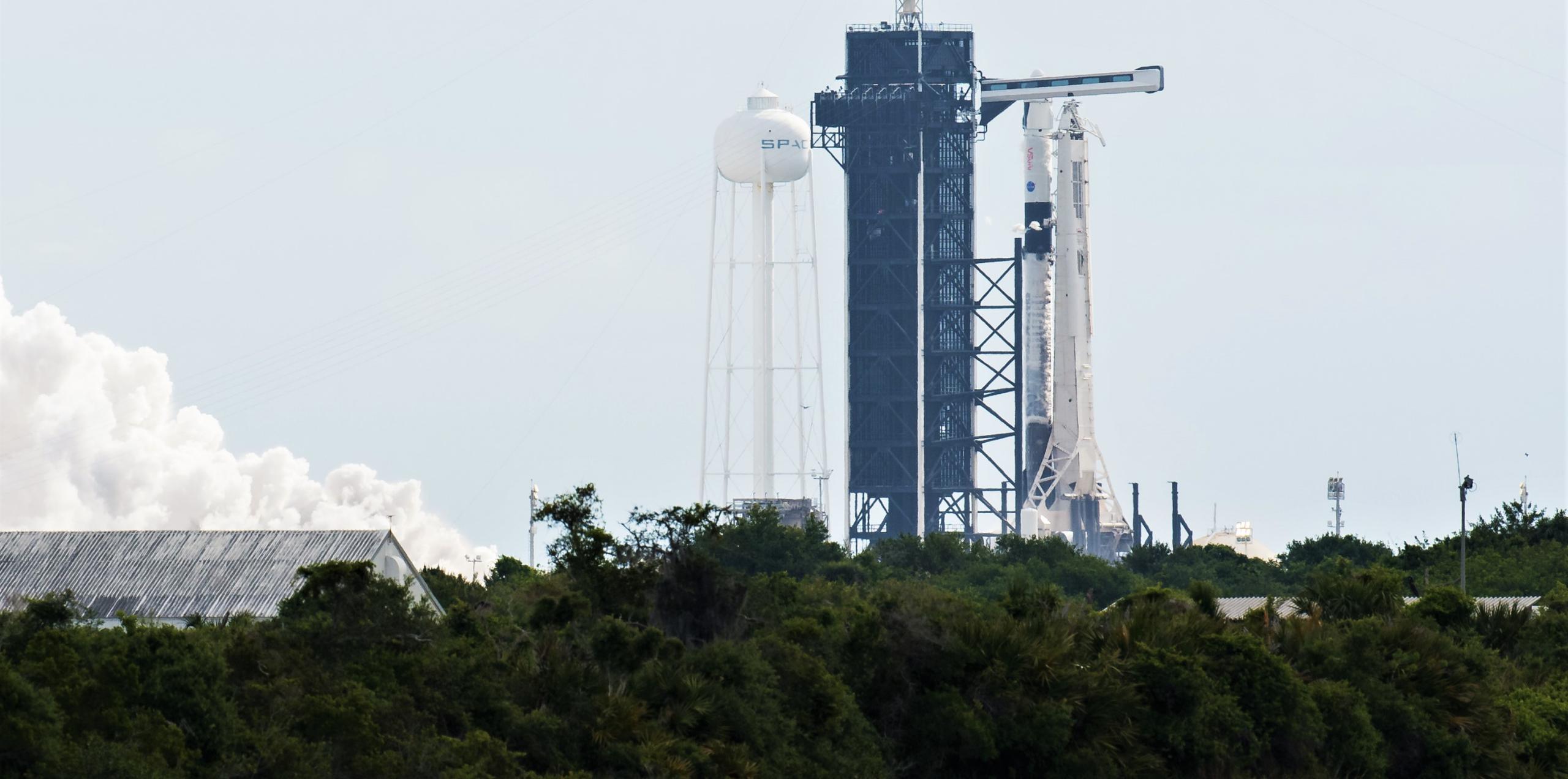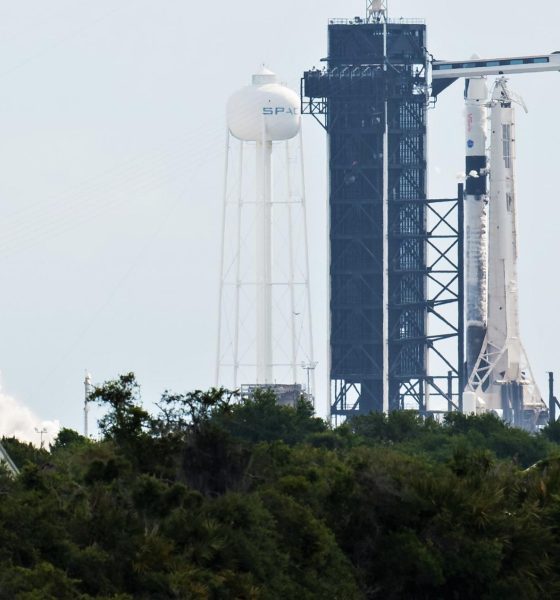SpaceX has successfully static fired a Falcon 9 rocket scheduled to launch another batch of NASA and ESA astronauts after the crew “completed a full rehearsal of launch day activities.”
However, poor weather and strict operational limits have prevented a separate group of private astronauts known as Axiom-1 from boarding a different Crew Dragon and returning to Earth as planned, delaying Crew-4 from April 23rd to no earlier than (NET) April 26th.
In a twist of fate that can be partially blamed on SpaceX, the ISS only has two docking ports (parking spots) capable of receiving Crew Dragon. NASA technically contracted Boeing to build three such ports but the first was destroyed when Falcon 9 failed catastrophically while attempting to launch Cargo Dragon’s CRS-7 space station resupply mission in June 2015. For unknown reasons, close to seven years later, NASA still hasn’t so much as attempted to build or launch a replacement docking adapter. As a result, most NASA cargo or crew missions have become more sensitive to the delays of other spacecraft and missions as NASA and its providers attempt to juggle a packed manifest with just two parking spots.
The lack of a third docking port and constraints on the use of one of the two remaining ports has forced NASA to repeatedly undock and redock Crew Dragons to set the stage for new arrivals and also limits the number of launch opportunities available to certain crew and cargo missions. Now, following the start of a series of Axiom Space Crew Dragon missions carrying private astronauts to the space station, NASA has yet another class of visiting vehicle to plan around.
Somewhat unsurprisingly, the close proximity of Axiom-1 and Crew-4, the presence of just two docking ports, and Crew Dragon’s fairly strict operational limits have combined to create added pressure and cause a mess of delays. Following Axiom-1’s April 8th launch, the Ax-1 Crew Dragon joined Crew-3’s Crew Dragon at the International Space Station (ISS).
To ensure a continuous US/European presence aboard the station amid Russian threats against the outpost it co-operates with NASA and other international partners, Crew-3 can’t (or shouldn’t) leave until Crew-4 arrives. Crew-4 thus can’t launch until Axiom-1 departs and frees up a docking port. Originally planned to spend around 10 days in space after their April 8th launch, the Axiom-1 crew is still aboard the ISS 12 days later after concerns about safe recovery weather have repeatedly delayed their departure. Only late on April 20th did NASA, SpaceX, and Axiom settle on a new undocking date for Ax-1, slipping from the latest target of April 20th to no earlier than 8:35 pm EDT (00:35 UTC) on April 23rd with a splashdown now on April 24th. As a result, Crew-4 has been delayed to April 26th – 11 days after the original April 15th target.
It’s unclear what particular weather concerns caused such a delay; if this is a “perfect storm” event and just a matter of bad luck; or if this situation was made worse (or possible) by apparent Crew Dragon recovery restrictions that require extremely calm seas. Regardless, it’s hard to imagine that NASA and SpaceX will attempt another private space station mission so close to an operational Crew launch after the challenges and close to two weeks of delays Axiom-1 has caused Crew-4.

News
Tesla (TSLA) receives “Buy” rating and $551 PT from Canaccord Genuity
He also maintained a “Buy” rating for TSLA stock over the company’s improving long-term outlook, which is driven by autonomy and robotics.

Canaccord Genuity analyst George Gianarikas raised his Tesla (NASDAQ:TSLA) price target from $482 to $551. He also maintained a “Buy” rating for TSLA stock over the company’s improving long-term outlook, which is driven by autonomy and robotics.
The analyst’s updated note
Gianarikas lowered his 4Q25 delivery estimates but pointed to several positive factors in the Tesla story. He noted that EV adoption in emerging markets is gaining pace, and progress in FSD and the Robotaxi rollout in 2026 represent major upside drivers. Further progress in the Optimus program next year could also add more momentum for the electric vehicle maker.
“Overall, yes, 4Q25 delivery expectations are being revised lower. However, the reset in the US EV market is laying the groundwork for a more durable and attractive long-term demand environment.
“At the same time, EV penetration in emerging markets is accelerating, reinforcing Tesla’s potential multi‑year growth runway beyond the US. Global progress in FSD and the anticipated rollout of a larger robotaxi fleet in 2026 are increasingly important components of the Tesla equity story and could provide sentiment tailwinds,” the analyst wrote.
Tesla’s busy 2026
The upcoming year would be a busy one for Tesla, considering the company’s plans and targets. The autonomous two-seat Cybercab has been confirmed to start production sometime in Q2 2026, as per Elon Musk during the 2025 Annual Shareholder Meeting.
Apart from this, Tesla is also expected to unveil the next-generation Roadster on April 1, 2026. Tesla is also expected to start high-volume production of the Tesla Semi in Nevada next year.
Apart from vehicle launches, Tesla has expressed its intentions to significantly ramp the rollout of FSD to several regions worldwide, such as Europe. Plans are also underway to launch more Robotaxi networks in several more key areas across the United States.
News
Waymo sues Santa Monica over order to halt overnight charging sessions
In its complaint, Waymo argued that its self-driving cars’ operations do not constitute a public nuisance, and compliance with the city’s order would cause the company irreparable harm.

Waymo has filed a lawsuit against the City of Santa Monica in Los Angeles County Superior Court, seeking to block an order that requires the company to cease overnight charging at two facilities.
In its complaint, Waymo argued that its self-driving cars’ operations do not constitute a public nuisance, and compliance with the city’s order would cause the company irreparable harm.
Nuisance claims
As noted in a report from the Los Angeles Times, Waymo’s two charging sites at Euclid Street and Broadway have operated for about a year, supporting the company’s growing fleet with round-the-clock activity. Unfortunately, this has also resulted in residents in the area reportedly being unable to sleep due to incessant beeping from self-driving taxis that are moving in and out of the charging stations around the clock.
Frustrated residents have protested against the Waymos by blocking the vehicles’ paths, placing cones, and “stacking” cars to create backups. This has also resulted in multiple calls to the police.
Last month, the city issued an order to Waymo and its charging partner, Voltera, to cease overnight operations at the charging locations, stating that the self-driving vehicles’ activities at night were a public nuisance. A December 15 meeting yielded no agreement on mitigations like software rerouting. Waymo proposed changes, but the city reportedly insisted that nothing would satisfy the irate residents.
“We are disappointed that the City has chosen an adversarial path over a collaborative one. The City’s position has been to insist that no actions taken or proposed by Waymo would satisfy the complaining neighbors and therefore must be deemed insufficient,” a Waymo spokesperson stated.
Waymo pushes back
In its legal complaint, Waymo stated that its “activities at the Broadway Facilities do not constitute a public nuisance.” The company also noted that it “faces imminent and irreparable harm to its operations, employees, and customers” from the city’s order. The suit also stated that the city was fully aware that the Voltera charging sites would be operating around the clock to support Waymo’s self-driving taxis.
The company highlighted over one million trips in Santa Monica since launch, with more than 50,000 rides starting or ending there in November alone. Waymo also criticized the city for adopting a contentious strategy against businesses.
“The City of Santa Monica’s recent actions are inconsistent with its stated goal of attracting investment. At a time when the City faces a serious fiscal crisis, officials are choosing to obstruct properly permitted investment rather than fostering a ‘ready for business’ environment,” Waymo stated.
News
Tesla FSD v14.2.2 is getting rave reviews from drivers
So far, early testers have reported buttery-smooth drives with confident performance, even at night or on twisty roads.

Tesla Full Self-Driving (Supervised) v14.2.2 is receiving positive reviews from owners, with several drivers praising the build’s lack of hesitation during lane changes and its smoother decision-making, among others.
The update, which started rolling out on Monday, also adds features like dynamic arrival pin adjustment. So far, early testers have reported buttery-smooth drives with confident performance, even at night or on twisty roads.
Owners highlight major improvements
Longtime Tesla owner and FSD user @BLKMDL3 shared a detailed 10-hour impression of FSD v14.2.2, noting that the system exhibited “zero lane change hesitation” and “extremely refined” lane choices. He praised Mad Max mode’s performance, stellar parking in locations including ticket dispensers, and impressive canyon runs even in dark conditions.
Fellow FSD user Dan Burkland reported an hour of FSD v14.2.2’s nighttime driving with “zero hesitations” and “buttery smooth” confidence reminiscent of Robotaxi rides in areas such as Austin, Texas. Veteran FSD user Whole Mars Catalog also demonstrated voice navigation via Grok, while Tesla owner Devin Olsen completed a nearly two-hour drive with FSD v14.2.2 in heavy traffic and rain with strong performance.
Closer to unsupervised
FSD has been receiving rave reviews, even from Tesla’s competitors. Xpeng CEO He Xiaopeng, for one, offered fresh praise for FSD v14.2 after visiting Silicon Valley. Following extended test drives of Tesla vehicles running the latest FSD software, He stated that the system has made major strides, reinforcing his view that Tesla’s approach to autonomy is indeed the proper path towards autonomy.
According to He, Tesla’s FSD has evolved from a smooth Level 2 advanced driver assistance system into what he described as a “near-Level 4” experience in terms of capabilities. While acknowledging that areas of improvement are still present, the Xpeng CEO stated that FSD’s current iteration significantly surpasses last year’s capabilities. He also reiterated his belief that Tesla’s strategy of using the same autonomous software and hardware architecture across private vehicles and robotaxis is the right long-term approach, as it would allow users to bypass intermediate autonomy stages and move closer to Level 4 functionality.










